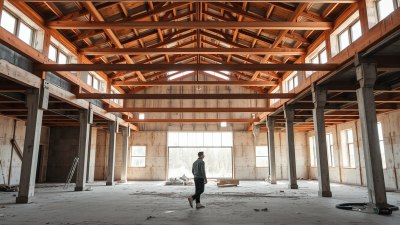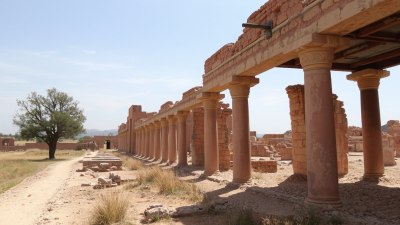You Stepped Into a Place That Isn’t Finished
Explore the realms of unfinished spaces and their stories. Discover beauty in the journey, not just the destination.

Image created with Flux Schnell
In a world that often prioritizes completion and finality, it's intriguing to consider the concept of unfinished places. An unfinished place could be a construction site, a work of art still in progress, or even a phase in a person's life. It holds a unique allure, embodying potential and the promise of what could be. These spaces are often overlooked, yet they possess a raw beauty that invites exploration and reflection. In this article, we delve into the significance of stepping into places that aren’t finished, exploring their stories, emotions, and the lessons they impart.
The Allure of the Unfinished
There's something captivating about unfinished structures. A skeletal building, with its exposed beams and incomplete façades, speaks of ambition and the dreams of its creators. It tells a story of aspirations yet to be realized. Visiting such sites can evoke a myriad of feelings—curiosity, melancholy, and a deep sense of possibility. How many ideas have been drafted within those walls? How many plans were laid out, only to be halted by circumstances beyond control? An unfinished place encapsulates these moments, offering a glimpse into the process rather than the polished end product.
A Metaphor for Life
The concept of being “unfinished” can also be applied to our personal journeys. Life is rarely a straight path; it's filled with twists, turns, and unexpected detours. Embracing our unfinished states can lead to profound personal growth. Just as a building needs time to develop and grow, so do we as individuals. Each phase of our lives contributes to the greater whole, even if it feels incomplete at times. By stepping into our unfinished selves, we acknowledge our potential for growth and change.
The Beauty of Progress
Unfinished places remind us that progress is a beautiful journey. The process of creating something, whether it be a building, a relationship, or a goal, is often more valuable than the finished product. It's in the mistakes, the learning moments, and the experimentation that true growth occurs. Embracing these moments can lead to richer experiences and deeper connections, as we acknowledge that imperfection is a vital part of the human experience.
Artistic Interpretation
Art thrives in the realm of the unfinished. Many renowned artists have left works incomplete, allowing viewers to ponder the possibilities. Such pieces invite interaction, interpretation, and imagination. The viewer is left to fill in the blanks, engaging with the art on a deeper level. This interaction creates a bond between the artwork and its audience, emphasizing the journey over the destination. In this way, unfinished art embodies the heart of creativity itself—constantly evolving, shifting, and redefining what it means to be complete.
The Psychology of Unfinished Spaces
Psychologically, unfinished spaces can evoke feelings of urgency or anxiety. The sight of an incomplete structure may trigger thoughts about goals we have yet to achieve or dreams left unrealized. These feelings are valid; they remind us that we are all works in progress. However, it's essential to balance this with an appreciation for the present moment. Instead of fixating on what isn’t finished, we can learn to find peace in the chaos of creation. Embracing the unfinished allows us to appreciate our current stage while still striving toward improvement.
Exploring Unfinished Spaces
For adventurers and urban explorers, unfinished spaces provide a thrilling opportunity to discover hidden stories. Abandoned buildings, ghost towns, and derelict sites often hold the remnants of their past lives. Stepping into these environments offers not only a rush of excitement but also a chance to connect with history. Each creak of the floorboards and each peeling wall tells a story—a narrative of dreams once dreamed, now left waiting for the next chapter. Exploring these spaces fosters mindfulness, encouraging us to reflect on the lives that once filled these places and the contrasts between then and now.
Unfinished Architecture Around the World
Globally, there are numerous examples of unfinished architecture that have intrigued historians and architects alike. One notable example is the Sagrada Familia in Barcelona, Spain. Designed by architect Antoni Gaudí, this basilica has been under construction since 1882 and is still not completed. Gaudí’s vision was grand and complex, and incorporating evolving techniques has allowed for a unique architectural feat. Visitors from around the world flock to witness this fusion of history, art, and progress—an epitome of potential. Another instance is the Casa da Música in Porto, Portugal, an unfinished concert hall that has become a cultural landmark despite its ongoing evolution. Such structures celebrate the beauty of impermanence and the idea that completion is not necessarily the end of a journey.
Lessons from the Unfinished
Stepping into unfinished spaces can teach us valuable lessons about patience, perseverance, and the significance of the journey. Life’s timelines are rarely aligned with our expectations. Learning to accept and even embrace the incomplete can free us from the pressures of perfectionism. In doing so, we create space for exploration, creativity, and ultimately, growth. It develops resilience and a deeper understanding of our paths. Life does not need to be perfectly orchestrated for it to be worth living.
The Importance of Community in the Unfinished
Communal projects often exemplify the concept of being unfinished. Community gardens, art installations, and cooperative buildings reflect a shared vision that evolves over time. These projects invite collaboration and creativity from different perspectives, fostering connections among community members. As each person contributes their unique touch, the collective vision gradually takes shape, highlighting the significance of teamwork and the understanding that everyone has a role in the process. Celebrating these unfinished collaborations cultivates a sense of belonging, reminding us that we are all works in progress, and that together, we can create something extraordinary.
Mindfulness in the Imperfect
To truly appreciate the beauty of every stage of life, we must practice mindfulness, embracing the moments of uncertainty and discomfort. Meditation can greatly assist in this process. By allowing our thoughts to surface while focusing on our breath, we create space to acknowledge our unfinished feelings without judgment. This practice opens the doorway to acceptance—seeing ourselves in the same light as those unfinished buildings and artworks, worthy of attention and love, regardless of our current state. Mindfulness helps us shift our focus from the need for completion to an appreciation of the ongoing journey we are all on.
Embracing the Unfinished
In conclusion, stepping into unfinished spaces invites us to explore not only the physicality of these places but also to reflect upon our own journeys. Unfinished structures, art pieces, and life phases teach us invaluable lessons about potential, progress, and the beauty of being a work in progress. They challenge us to redefine our perceptions of success and completion. Ultimately, embracing the unfinished can lead to a deeper understanding of ourselves, our relationships, and the world around us. As we navigate through life’s complexities, let us honor the unfinished nature of our journeys, finding beauty and meaning in every moment.











